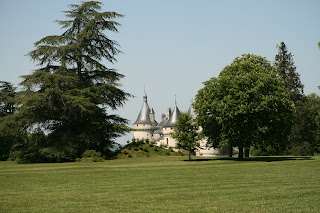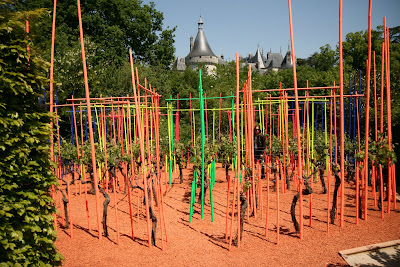
The château at Chaumont was built in the 15th and 16th centuries with a great deal of influence by Catherine de Médicis, who wrenched it away from Diane de Poitiers in exchange for Chenonceau (which I plan to cover a bit later). It sits on a plateau overlooking the Loire River with a dry moat surrounding it and is accessed solely by drawbridges.

The garden at Chaumont did not come into being until the 19th Century, when the Count of Aramon planted what is now an arboretum. This was developed later by Prince de Broglie in collaboration with Henri Duchêne into a park reminiscent of the English country gardens of Capability Brown and Humphry Repton. To create this pleasure park, extensive lawns were planted and trees were imported from throughout the Mediterranean world--mostly Cedars of Lebanon. The trees also serve to control erosion on the bluff. The Château became the property of the government around 1938 and is "devoted to the relationship between nature and culture, artistic creation and the impact of landscape, our heritage and contemporary art."



If you approach Chaumont from the main entrance at the intersection of rue Maréchal Leclerc and rue du Village Neuf, (17 km southwest of Blois and 20 km northeast of Amboise), a path climbs up the hill from the village and winds through the park to the château. There is also a parking lot at the top, near the entrance to "Festival International des Jardins" (the Festival of Gardens) which is held annually from May to mid-October.

Careful siting of the trees, and the addition of shrub groupings, frames views of the château and the river and develops a myriad of outdoor spaces to accommodate groups of visitors who come daily to enjoy the park, especially during the time of the garden festival. In the park, one also finds installations by artists which remain in place for varying periods.

Black granite "Place of Dreams" seat along the Loire Esplanade, by Anne and Patrick Poirier.


The images above and below show a piece created in-situ by François Méchain: L'Arbre aux échelles (The Tree with Ladders).

Below are images of blackened wood pieces by Rainier Gross, installed in 2008 (Toi[t] en perspective and Toi[t] à terre).



Starting in April there are temporary installations in the park by contemporary artists. In 2010, Anne and Patrick Poirier had eight installations here, including this one--"L'Oeil de l'Oubli" (The Eye of Memory):

-carved in white marble.
In the Organic Kitchen Garden section of the Domaine, there are permanent installations, including an early one by Patrick Blanc.

Other installations in the Organic Kitchen Garden exhibit aesthetically pleasing ways to grow vegetables and herbs while employing environmentally sound processes.








Espaliered fruit trees.

Yes, that is a giant rabbit topiary in the background. Chaumont prides itself on a tradition of avant-gardism.

Throughout the Domaine the care for the plantings and the details used for common and purely utilitarian objects are of a high standard and done with an artistic flare. Above is the screening at the restroom facility.

This cage makes a safe covering over a drainage ditch, using recycled materials.

Shrub and perennial borders in the Festival area.

Since 1992, Festival International des Jardins (the garden festival) has provided a venue for designers, landscape architects and artists to build individual small-scale gardens in a separate area of the Domaine, each year with a single theme. It is the inspiration for venues like Cornerstone in the Sonoma Valley, California. Some of the gardens within the Festival zone at the west end of the Domaine, are semi-permanent, while the annual show exhibits about 30 ephemeral ones. One of the most attractive constant features is Vallon des brumes (valley of mists), where a wet trail leads down into a small, lush canyon with cascades and streams. Light catches an intermittent mist.







Within permanent buildings near the Entrance there are also installations at the "Château Farm".

Hayloft Gallery: Bob Verschueren--a Belgian visual artist who used trees and branches from the Domaine for his pieces.


In the wading pool: "Reflexion" by Bob Verschueren -- made of two uprooted trees.

In the Bee Barn, Marie Denis used bundles of lucerne with wicker and sedge to create her installation.





The Greenhouse also presented some installations as well as some interesting tropical plants.


Painted wood "Posts" by Côme Mosta-Heirt.


The 2010 theme for the Festival was "Body and Soul Gardens" (Jardins corps et âme). The composers of the text in the brochures made no apologies with regard to the power of the garden in human lives. " 'Touching the earth' has an impact on our internal equilibrium and it has been possible to measure the power of the garden on cerebral and neurological pathologies." As with other garden shows, the Festival's aim is to entertain, enchant, surprise and offer ideas for one's own garden.
And now, some of the 2010 festival gardens.














